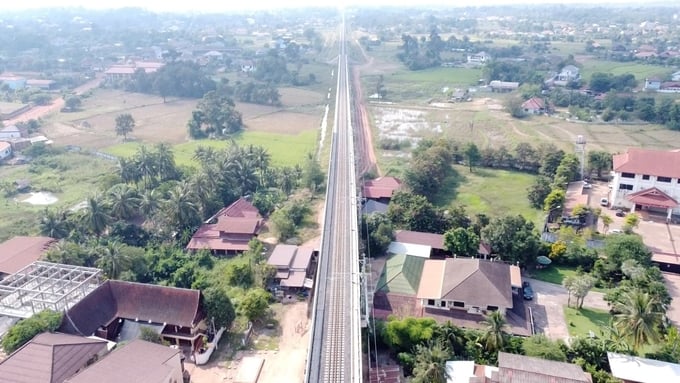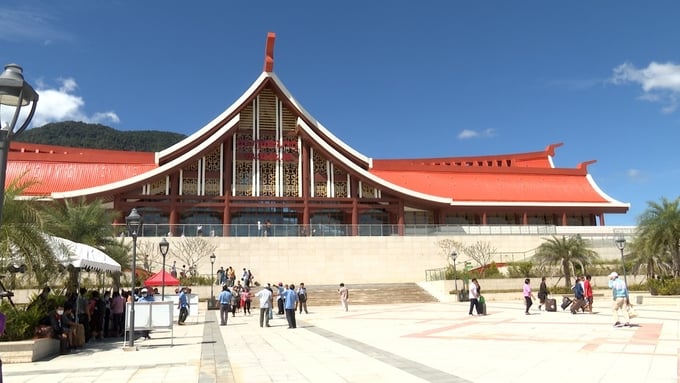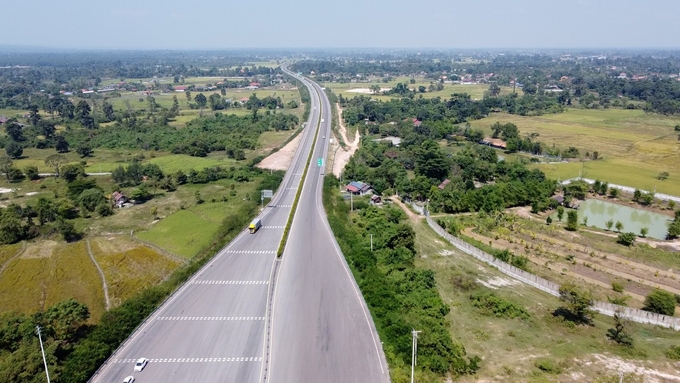June 17, 2025 | 12:53 GMT +7
June 17, 2025 | 12:53 GMT +7
Hotline: 0913.378.918
June 17, 2025 | 12:53 GMT +7
Hotline: 0913.378.918
We arrived in Vientiane right at the time when the capital of Laos was hosting World Food Day and International Day for the Eradication of Poverty. Many people attended, even domestic delegates and international guests. And while at the event, we could hear everyone mentioning “a new light” to the Land of a Million Elephants after the Vientiane - Kunming high-speed railway comes into operation at the end of 2021.

Vientiane - Kunming high-speed railway.
Somephone Phanusith had an appointment with us at a hotel near the event venue. The seat was still not warm, but the man who once worked as an adviser to the former Prime Minister of Laos Bouasone Bouphavanh hurriedly brought us to the car and talked while walking. We went and saw the Vientiane Railway Station of the Laos - China high-speed railway, then go to the Laos - China highway road that is being built to run along Laos, connecting with China and Thailand. We kept going, and finally stopped and had a chat with each other on the bank of the Mekong River. From that spot, we could see the capital Vientiane and Thailand with ease.
Somephone Phanusith has never been more proud. For a long time the Land of a Million Elephants is thought to be consistently among the poorest countries in Southeast Asia. But things have changed. With great determination, now Laos owns Southeast Asia's first high-speed rail line.

Laos - China Expressway.
The railway has nearly 500 km in the territory of Laos with an average speed of 120km/h for freight trains and 160km/h for passenger trains. In the past, traveling by road from Vientiane to the Boten border adjacent to China took about 2 days and 2 nights, now thanks to this high-speed railway, it only takes 4 hours. Right from the time of construction, Laos’ agricultural development strategy was also re-planned. The priority area for agricultural commodity investment, concentrated along the Laos-China railway, has become a national imperative.
Somephone Phanusith also said that besides this railway, the highway connecting the Laos-China border to capital Vientiane and continuing to the southern region of Laos is also under construction. Saying in a poetic manner, the “traffic arteries” are opening up more and more, the new era "silk road" is about to take shape, and all of these are happening on the Land of a Million Elephants.

Luang Prabang Station on the Laos-China high-speed railway.
But the Laotian dream does not stop there. In the future, they want to build Highway 13 South to Vietnam and Cambodia along the old route. There would also be a completed expressway that is planned from the existing expressway going through Xiangkhouang, Houaphanh to the Vietnam border in the north.
A new day in Vientiane Capital. The autumn sun radiated on Patuxai Monument – Laos’ symbol of victory. We decided to buy tickets to board the high-speed rail train from Vientiane to Kunming. The conversation with Somephone Phanusith further spurred our desire to experience what it would be like to ride on Southeast Asia's first high-speed rail line. It was weekend that day. Although Vientiane Railway Station was very crowded, people travel quite sequentially. The Laotian translator said that since the opening of the high-speed railway, the demand for travel on the routes had increased dramatically.
From Vientiane to Boten there are 4 stations. The fare for the first class car for the whole route is 529,000 Laotian kip, equivalent to VND 760,000. The second class car is 333,000 kip, around VND 480,000. Going through the ticket gate, then sitting in a spacious, modern and tight train waiting room, we felt like we were going on an airplane. Each carriage is modernly designed, with a team of attentive service staff. The long road goes through the mountains, through the valleys, through the fields, through the rivers. The high-speed train of the Laos - China railway line soared like an arrow toward the front.
Before boarding the Vientiane - Kunming high-speed train, we divided into two groups to do a comparative test on the same distance from Vientiane to Luang Prabang. While the high-speed train took only two hours, the other group chose to travel by car and it took them a whole day to reach the destination.
Phaykham Phalixai, owner of Sun Trade Service and Import Export Co., Ltd – Laos, gave us further explanation. “This high-speed rail system has turned Laos from a country located deep in the continent and landlocked to an important link connecting transportation, shortening the time and cost of transporting goods greatly compared to road. It used to take two days and nights from Vientiane to Kunming, now it is only 7 hours. From living, traveling, traveling to visiting relatives, everything is convenient for the people.”

The "trans-Laos" highway.
That’s not to mention the Laos-China high-speed railway that has created a tourism boom in Laos. Train stations in Luang Prabang city, Vang Vieng town and Vientiane capital are always full of tourists. A few years before the Covid-19 epidemic, every year the Land of a Million Elephants welcomed 6-7 million tourists. This year that number has increased to nearly ten million people.
After the Laos - China high-speed railway project, Laos is also considering the Vientiane - Vung Ang railway project connecting Laos - Vietnam. It was another dream, another huge ambition. Having a long time friendship, the governments of Vietnam and Laos have made efforts to support connecting the Land of a Million Elephants with Vung Ang Port in Ha Tinh. The project is there, the construction plan has also been agreed upon. It is expected that when it comes into operation, the Vientiane - Vung Ang railway will be the "blood vessel" directly connecting the goods markets of Laos, Thailand and Myanmar with Vung Ang Port. The roads from Vietnam, Thailand, Cambodia, China go through Laos, that’s what Laos wants for its logistics center.
Souvanh Keosavang is a man of Vietnamese origin. in his ancestor was born in Huong Son district (Ha Tinh). Being more than the Chairman of the cross-border retail supermarket chain Jmart, he is also a member of several joint ventures between Vietnam and Laos. This person thoroughly understands the new opportunities and opportunities of Laos and also thinks a lot about how to connect and cooperate between countries in the region.
According to the calculation of those who regularly work in the agro-product import-export field to the Chinese market, thanks to this high-speed railway, Thai people can shorten the time by about 24 hours and reduce transportation costs by more than 25%. From taking 2-3 days to transport agro-products to Kunming (China), now Thailand is just one step across the Mekong River, then spends a few more hours in Laos to be able to sell goods.
“Such analysis also means discussion for solutions. To me, more than ever, Vietnamese businesses, especially those in the agricultural sector, should go to Laos to invest now. Potential and advantages have been identified. Aspiration and development strategies were clear. The Land of a Million Elephants is rising strongly to become the region’s logistics center. There's no reason why we shouldn't take advantage of our long-standing neighborly friendship to grow stronger together," Souvanh Keosavang said.
Translated by Samuel Pham
/2025/06/12/3721-2-202745_83.jpg)
(VAN) TH made an impression at Seoul Food 2025 with its line of natural beverages, paving the way for Vietnamese food products to enter the South Korean market.

(VAN) Soc Trang's success in rice exports stems from a strategy of developing fragrant and specialty rice cultivation areas and standardizing production toward low-emission practices.
/2025/06/11/1311-5-120811_839.jpg)
(VAN) The pig farming industry is facing the challenge of comprehensive restructuring to meet requirements for quality, safety, traceability, and market expansion both domestically and for export.

(VAN) Vietnam considers participating in ALGROALBA in order to expand agricultural production, coordinate the assessment and effective exploitation potential land.
/2025/06/05/5314-1-184727_407.jpg)
(VAN) From seemingly worthless fish scales and skin, enzymes and lactic ferments can transform by-products into peptides, opening a sustainable, effective business direction and elevating Vietnamese seafood.

(VAN) TTC AgriS and IFC signed a strategic partnership to develop a sustainable agricultural value chain, aiming to achieve the Net Zero target by 2035.

(VAN) Seafood by-products are opening a new path, combining green growth and technological innovation to enhance the industry's value.